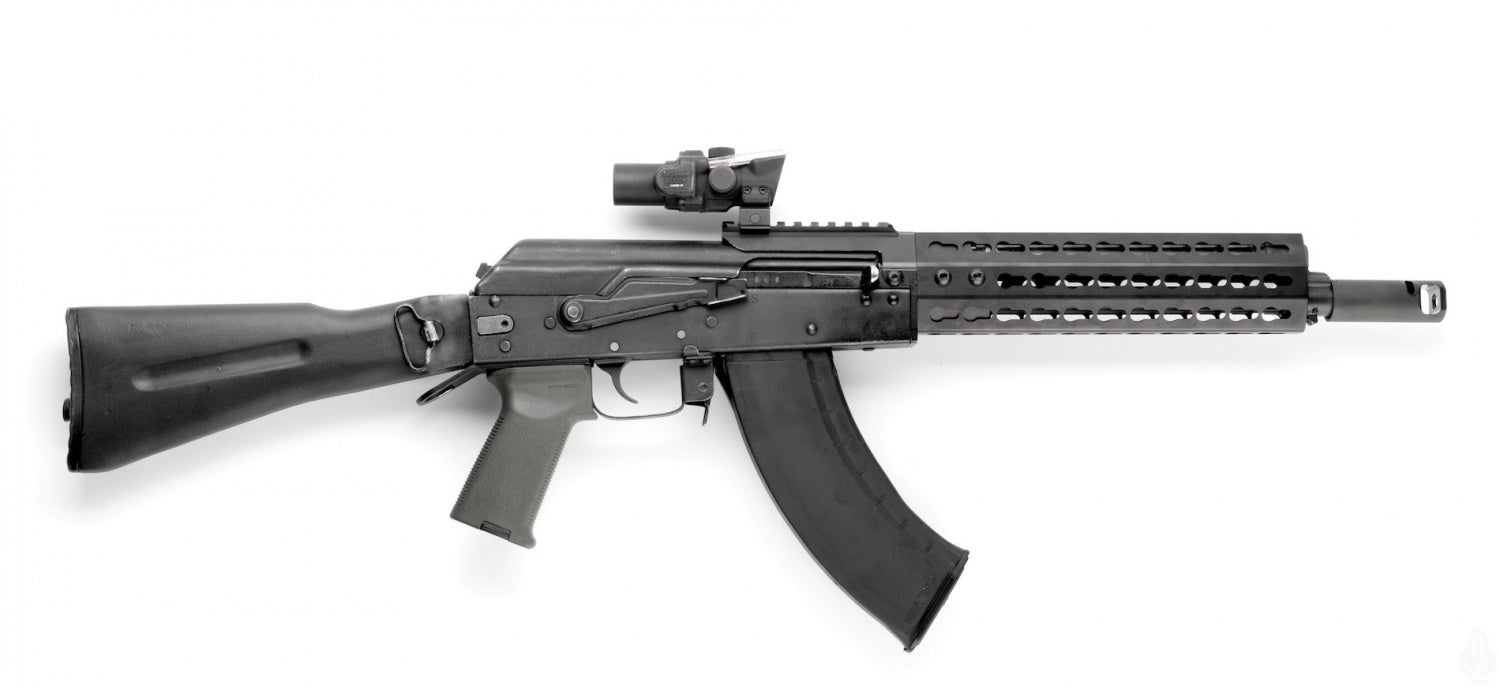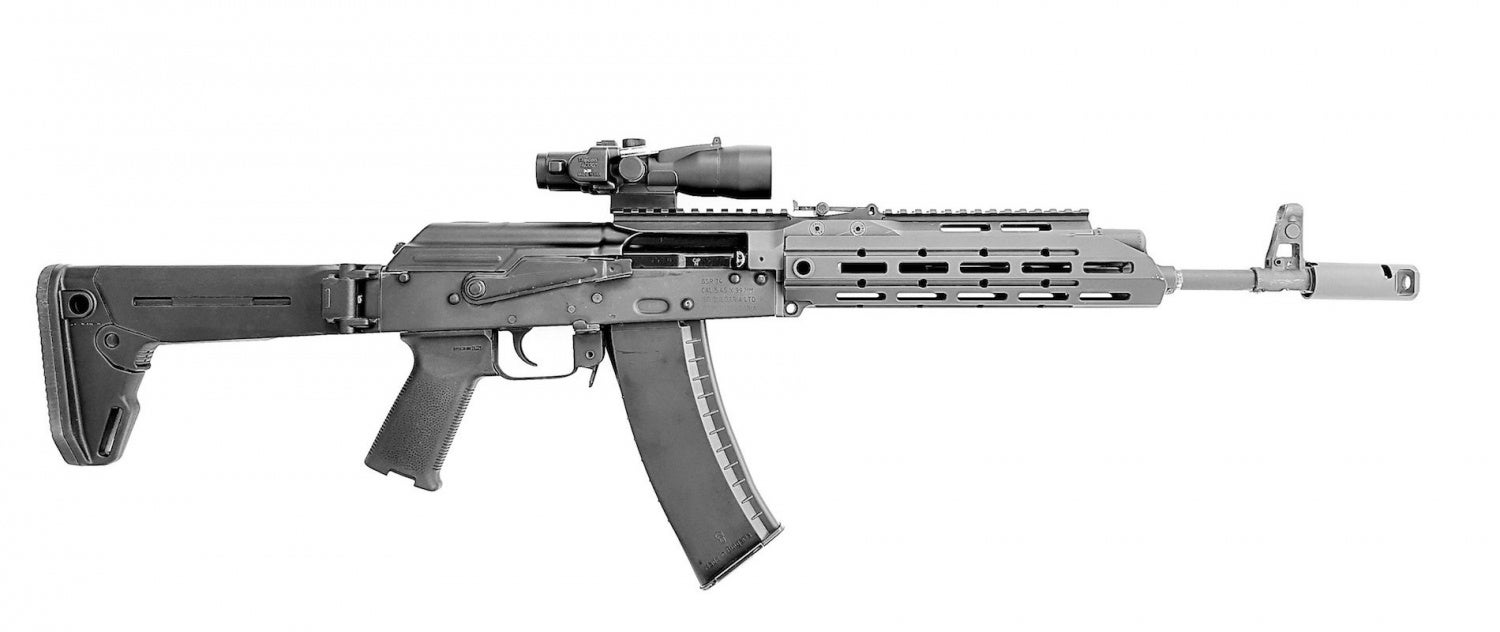Before we begin talking about the Sureshot Armament MK3, let’s see why this concept of “chassis system” even came to exist on AKs. If we’ll take an honest look at most rifles we are using today, it seems that the progress stopped somewhere around 1959. In that year, Colt started manufacturing AR-15 designed by Eugene Stoner, and IZHMASH, the biggest Soviet arms factory, began mass production of the AKM, the direct predecessor of most Kalashnikov rifles we see today.
Since then, very little has changed in terms of ballistics and internal design. Same ammunition, same gas-operated firearms, and manufacturing technologies. But one thing has changed dramatically – sighting systems. And AR-15 happened to be much better suited for modern red dots, optics, night vision, IR lasers, and lights.
It is easy to love an AK – its history, simplicity, durability, but frankly, finding a good optics mount for an AK was always a real problem. And these days a rifle without a modern sight is simply obsolete. So the “chassis” was developed to bridge that gap between an AK and AR and make sight installation on Kalashnikov as easy as it is on AR-15.
Sureshot Armament @ TFB:
- Sureshot Armament Group Factory Tour, Range Trip and News
- Lightweight Remington 700 Chassis by Sureshot Armament Group
- Sureshot Armament Group AK Handguard MK1
- Sureshot Armament Group MK2.1 Drop-In AK Chassis

Author’s personal AK carbine with Sureshot Armament MK3 Chassis
In my article, written over 4 years ago, Red Dot Sights on AKs – Critical View (Part 2), I went over some of the most popular solutions, and ever since, I’ve been looking for a better way to mount optics and IR lasers on an AK. And the “chassis system” makes a lot of sense. There were a few attempts to make something like this, but so far Sureshot’s variant seems to be the most popular.
The company called Sureshot Armament Group (SAG) was founded in 2014 in the Czech Republic by Valentin Vlasenko, the design engineer and master class IPSC shooter. In 2016, he opened a branch in Russia and started manufacturing his modernization kit for the SVD Dragunov rifle. In 2017, my fellow TFB writer Hrachya H. visited the SAG factory in Moscow and tested their SVD Chassis.
The concept of “chassis” combines a handguard with M-LOK or KeyMod slots with a rigid optic mount over the upper receiver. It solved two problems at once, you have a modular handguard for lights and lasers and a rigid mount for your primary optics. Interesting concept, but in 2016, when the first gen chassis first came out, I was very skeptical.

Sureshot Armament Group (SAG) first-generation AK chassis
First, I was really curious about it, checked out the prototype, and frankly – it was a fascinating idea, but definitely not something I would personally use. To install the chassis, you had to get rid of the rear sight block, front sight, and replace the barrel pin.
The final result was extremely light, but you had to be a decent gunsmith to install one and there were so many opportunities to screw up during the process. Also, with this setup, you lose your iron sights, which is a big deal for many people. I don’t like to mess with things that work well, especially on an AK.
Then, in 2018, came the MK 2.0. It had an M-LOK instead of KeyMod and you could install rear sight into the upper handguard.

Sureshot Armament Group (SAG) MK 2.0
But, to install it, one still had to get rid of the rear sight block and detach the front sight and gas block, which is almost impossible on some mil-spec AKs, since their barrel components were pressed into the barrel.
Then, in 2019, MK 2.1 chassis came out, a nice drop-in variant, the first one that I actually liked. With an exception of a handguard that was too wide for my taste, it was basically perfect – the installation process was simple, it added very little weight to the rifle, and provided a stable base for optics and lasers.

Sureshot Armament Group (SAG) MK 2.1 chassis
And now, the USA-based company Sureshot-USA presented MK 3.0, began production of the next generation of the chassis system. For the US market, MK3 will have the same wide handguard as MK2.1, similar to Bushmaster ACR. For the Russian market, the handguard will be slim, following the request from Russian special forces, which have been testing this chassis system for the last four years.
When I heard about the slim handguard I was hooked – the width of the handguard was my only complaint about the MK2.1, so I requested one chassis for review. The entire installation process took about 20 minutes – my friends and I were halfway through our BBQ party when I remembered I still need to put MK3 on my carbine. I asked my friend who just finished his second pork chop: “Hey, bro, did you bring you Dremel? Let’s go upstairs and install this thing before we are too drunk to handle any guns”.
We cut off the handguard retainer with a Dremel tool, installed a new gas tube and the main clamp that retains the lower and upper handguard. Everything was pretty intuitive, we never even checked the manual, and in a few days, I hit the range with a shorty AK with my favorite Aimpoint T2.

Author personal AK carbine with Sureshot Armament MK3 Chassis.
MK3 handguard is free-floating, two screws on the sides are retaining the gas tube, and you should be careful when tightening them the first time. If you tighten it up too much on one side the gas tube might shift a little, so make sure you tighten them one after another, a little bit at a time, on both sides. You might also want to use Loctite on those screws.
The biggest update MK3 got compared to MK2.1 is a longer rail. The back portion of the rail is basically a replacement of a standard receiver cover, only it’s about 60% shorter than the standard AK dust cover. In the picture above you can see the line between the front and back portion of the rail.
The solid front portion of the rail is used to mount optics, while a relatively small, detachable back portion is used for magnifiers or night vision monoculars (if you’re one of those people who are too lazy to have their night vision on a helmet). Also, after you detach the back portion of the rail, you can then disassemble the gun like you normally would for cleaning and maintenance, without removing the optics.

USA version of MK3 chassis system.
The handguard is slim and comfortable. I thought about testing how much it heats up when you shoot 4 or 5 magazines continuously, but then I remembered what the ammo prices are these days and decided that I can do this test later when I can use someone else’s ammunition.
Overall, the MK3 chassis system seems like a good solution for someone who is ready to pay top dollar for high-end accessories. If you’re on the budget, you can just buy a good side mount for your red dot, and regarding lasers… Well, you’re on a budget, so what lasers are we even talking about.
Do you need an MK3 if you just want to mount a red dot on your AK? Probably not. Just like nobody needs a Porsche or a Shelby GT to drive around town. But thankfully, we can still get the things we want, without limiting ourselves to the bare minimum. And for sights, lights, and lasers on my AK, I want the MK3.
 Your Privacy Choices
Your Privacy Choices
